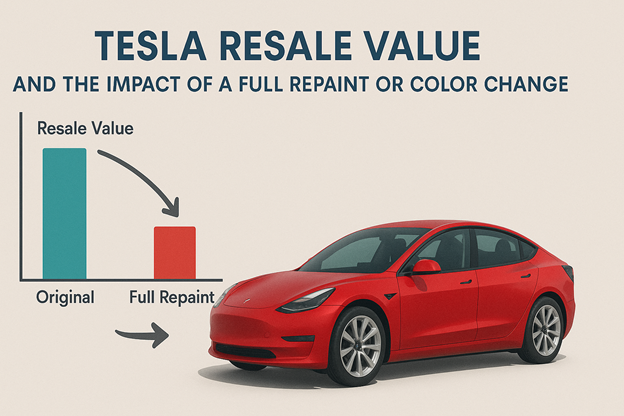Tesla Resale Value and the Impact of a Full Repaint or Color Change
Tesla vehicles have established a remarkable reputation for strong resale value retention compared to traditional luxury and electric vehicle competitors, with many models maintaining 60-70% of their original purchase price after three years of ownership. This exceptional value retention stems from multiple factors including Tesla’s brand strength, limited production volumes relative to demand, the electric vehicle market’s rapid growth, continuous over-the-air software improvements that enhance functionality over time, and the company’s extensive Supercharger network that provides practical advantages unavailable to competing EVs.

However, Tesla owners contemplating full vehicle repaints or color changes face complex decisions regarding how these modifications might impact future resale value and marketability. Whether motivated by accident damage requiring extensive paint repair, dissatisfaction with original color choice, desire for a unique appearance, or correction of factory paint defects, understanding the resale implications of repainting becomes essential for making informed decisions. For Tesla owners in Dubai and throughout the UAE, where the luxury vehicle market exhibits particular sensitivity to originality and condition, working with qualified tesla bodyshop in dubai facilities and understanding market dynamics proves crucial for protecting investment value.
Understanding Tesla’s Factory Paint Premium and Buyer Expectations
Tesla’s factory paint offerings have evolved significantly over the company’s history, but certain fundamental principles remain consistent regarding how paint affects vehicle value and buyer preferences. The company charges substantial premiums for premium colors beyond the standard offering, with multi-coat and specialty finishes commanding price increases ranging from $1,000 to $2,500 or more depending on model and market. These factory color premiums reflect not only the actual cost of premium paint materials and application complexity but also the perceived value and desirability of distinctive finishes.
The factory paint application process incorporates Tesla’s proprietary multi-layer system with specific formulations, application procedures, and quality control measures that create distinctive appearance characteristics. Buyers familiar with Tesla vehicles can often recognize factory paint quality through its depth, uniformity, and the specific appearance of metallic or pearl effects that characterize authentic Tesla finishes. This factory authenticity carries inherent value in the resale market, as buyers perceive original paint as an indicator of overall vehicle care, lack of accident history, and authentic condition.
The UAE’s luxury vehicle market demonstrates particular emphasis on originality and provenance, with buyers placing significant value on vehicles that retain factory specifications and documentation. The region’s affluent buyer base typically includes collectors and enthusiasts who scrutinize vehicle history and condition carefully, making modifications that alter original specifications potentially problematic for resale regardless of quality execution. This market characteristic applies broadly across luxury segments, with Tesla experiencing similar buyer expectations despite its relatively recent market entry.
Color choice significantly impacts resale value independent of whether paint is factory original or aftermarket applied. Neutral colors including white, black, silver, and gray typically offer the broadest market appeal and strongest value retention, as they appeal to the widest buyer demographic and present the least controversial appearance. Tesla’s Pearl White Multi-Coat has emerged as particularly popular in UAE markets, combining elegant appearance with heat-reflective properties that provide practical benefits in extreme climates while commanding premium pricing both new and used.
Distinctive or unusual colors present more complex value propositions. While bold colors like red or blue may appeal strongly to certain buyers and potentially command premiums from buyers specifically seeking those colors, they simultaneously narrow the potential buyer pool and may extend selling times. Custom or non-factory colors amplify this effect dramatically, as they appeal only to buyers who appreciate the specific color choice while potentially deterring buyers who would accept factory colors but find custom colors objectionable.
The documentation associated with repainting profoundly influences resale impact. A full repaint with comprehensive documentation explaining the reason, detailing the work performed by reputable facilities, and providing receipts demonstrating quality investment may be viewed quite differently from repainting without documentation or with vague explanations. Transparency regarding paint work history allows buyers to make informed assessments rather than speculating about potentially problematic accident history or other concerning scenarios.
Scenarios Where Repainting Adds Value or Minimizes Loss
Despite general principles suggesting original paint preservation maximizes value, specific scenarios exist where full repainting may enhance resale value or at minimum limit depreciation compared to retaining damaged original paint. Understanding these scenarios helps Tesla owners make appropriate decisions when facing paint-related issues.
Vehicles that have sustained significant paint damage from accidents, hail, vandalism, or environmental factors may benefit from professional repainting rather than attempting to sell with visible damage. Buyers heavily discount vehicles with obvious paint damage, often assuming more extensive problems exist beyond visible issues. The discount buyers apply to damaged paint typically exceeds the cost of professional repair, making preemptive repair economically rational. However, the repair must achieve genuinely high quality that appears indistinguishable from factory finish under normal inspection, as mediocre repair work creates different but equally significant value concerns.
Factory paint defects or quality issues affecting multiple panels or extensive areas present situations where repainting by qualified car painting in Dubai facilities may prove beneficial. Tesla’s earlier production years occasionally experienced paint quality inconsistencies, with some vehicles exhibiting orange peel texture, thin coverage, or other defects that detract from appearance and buyer perception. When such defects fall outside warranty coverage or owners prefer independent correction, professional repainting that improves upon factory quality can enhance both aesthetic appeal and buyer perception, particularly when accompanied by documentation explaining the factory issues and correction procedures.
Color correction from unpopular or problematic factory colors to neutral, high-demand colors may improve marketability despite the repaint disclosure. If a vehicle’s original color demonstrates poor resale performance in local markets or limits buyer appeal, strategic color change to neutral tones could expand the buyer pool sufficiently to offset the repaint disclosure impact. This scenario proves most viable when original paint has already experienced damage or deterioration requiring correction, allowing color change as an incremental addition to necessary repair work.
Climate-related paint deterioration common in UAE conditions presents another scenario where repainting may prove beneficial. Vehicles experiencing extensive UV damage, oxidation, or environmental degradation present poor appearance that significantly impacts buyer perception and marketability. Professional paint correction through comprehensive refinishing can restore appearance to like-new condition, potentially commanding premiums over comparable vehicles showing age-related deterioration despite original paint retention.
The Risks and Value Impact of Full Repaints and Color Changes
While specific scenarios support repainting decisions, substantial risks and value impacts exist that Tesla owners must carefully consider before proceeding with full repaints or color changes. These considerations become particularly acute for color changes away from factory specifications, which trigger more significant buyer concerns than same-color repaints addressing damage or deterioration.
Documentation and disclosure requirements create potential complications for repainted vehicles. Most jurisdictions including UAE require disclosure of repainting when it relates to accident damage, with failure to disclose creating legal liability and transaction risks. Even voluntary repainting unrelated to accidents may require disclosure to avoid misrepresentation claims. These disclosure requirements mean that repainting cannot be concealed from sophisticated buyers, who typically request paint thickness measurements, professional inspections, or vehicle history reports that reveal paint work.
Paint thickness measurement technology has become widely accessible and is commonly employed by professional vehicle inspectors and knowledgeable private buyers. These electronic gauges accurately measure paint thickness at multiple points across vehicle surfaces, revealing areas where paint has been removed and reapplied through lower or higher than factory thickness readings. While quality repainting by experienced facilities can achieve thickness measurements within acceptable ranges, the measurements still typically differ from factory specifications in ways that trained inspectors recognize.
The quality variability of aftermarket repainting represents a significant concern for buyers, who understand that paint application quality ranges dramatically between facilities and technicians. Even when sellers provide assurances about work quality and facility reputation, buyers heavily discount repainted vehicles to account for uncertainty about actual quality versus claims. This discount often proves substantial, potentially reaching 10-20% of vehicle value depending on extent of repainting, quality perception, and overall market conditions.
Color changes away from factory offerings trigger particularly significant value impacts. Buyers view non-factory colors as modifications reflecting previous owner preferences that may not align with their tastes, while simultaneously raising questions about motivation for color change and whether it conceals more extensive damage or problems. The narrowed buyer pool for non-standard colors extends selling times and may force price reductions to attract the limited number of buyers willing to accept custom colors.
Registration and documentation complications can arise from color changes depending on jurisdiction requirements. Some locations require official documentation and approval for color changes, with associated administrative burdens and costs. Insurance implications may also exist, particularly if color change affects vehicle value or replacement cost calculations. These administrative complications add to the overall cost and complexity of color changes while potentially creating future resale complications if documentation proves incomplete or questionable.
The permanent nature of repainting decisions means that value impacts persist throughout vehicle ownership and transfer to subsequent owners. Unlike modifications that can be reversed or removed, paint changes permanently alter the vehicle in ways that affect all future transactions. This permanence demands careful consideration of long-term implications rather than focusing solely on immediate circumstances or preferences.
Best Practices for Minimizing Resale Impact When Repainting Is Necessary
When circumstances necessitate full repainting despite resale considerations, Tesla owners can implement specific strategies to minimize value impact and maintain maximum marketability. These best practices focus on quality assurance, documentation, and strategic decision-making that preserve buyer confidence and justify premium pricing.
Selecting qualified facilities with demonstrated Tesla expertise proves essential for achieving quality results that minimize resale impact. Not all body shops possess the specialized knowledge, equipment, and materials necessary for successful Tesla repainting that replicates factory finish characteristics. Facilities with specific Tesla certification or documented experience repainting multiple Tesla vehicles demonstrate the expertise necessary for optimal results. Requesting examples of previous Tesla paint work, speaking with previous customers, and verifying facility capabilities before committing work helps ensure appropriate quality standards.
Maintaining comprehensive documentation throughout the repainting process provides transparency that reassures future buyers and supports value retention. Documentation should include detailed explanations of reasons necessitating repainting, photographs of condition before and after work, itemized invoices from reputable facilities, specifications of materials used including paint brand and formulation, and any relevant warranties or guarantees. This documentation package demonstrates professionalism and transparency that helps overcome buyer skepticism about repainted vehicles.
Color selection strategies should prioritize neutral, high-demand colors that maximize buyer appeal rather than bold or unique colors that narrow markets. When repainting becomes necessary, selecting colors like Pearl White Multi-Coat, Midnight Silver Metallic, or Solid Black provides the broadest appeal and strongest value retention. These colors match Tesla’s popular factory offerings, potentially allowing some buyers to view the repaint as less problematic than non-factory colors would appear.
Timing considerations affect resale impact, with immediate resale following repainting potentially raising more concerns than selling after a period of ownership demonstrating the quality and durability of paint work. Allowing some time between repainting and sale enables the owner to credibly demonstrate that paint work has held up well and that the vehicle has been properly maintained following the repair, reducing buyer concerns about immediate flipping or concealment of problems.
Professional pre-sale inspection and certification by independent third parties can help overcome buyer skepticism about repainted vehicles. Obtaining comprehensive vehicle inspections from recognized inspection services, having paint thickness measurements professionally documented, and securing condition certifications from qualified mechanics provides objective evidence about vehicle condition that supplements seller representations and documentation.
Pricing strategies should acknowledge the repaint history while emphasizing quality and value proposition. Attempting to price repainted vehicles identically to comparable vehicles with original paint typically proves unsuccessful, as buyers recognize the difference and discount accordingly. More effective approaches involve modest pricing reductions that acknowledge the repaint while highlighting quality work, comprehensive documentation, and overall excellent condition that justifies premium positioning within the repainted vehicle segment.
Alternative Solutions: Paint Protection and Correction Versus Full Repainting
Before committing to full repainting with its associated costs and resale implications, Tesla owners should thoroughly explore alternative solutions that may address concerns while preserving original factory paint. Modern paint protection and correction technologies offer increasingly sophisticated options that can restore appearance, protect against future damage, and maintain originality that supports resale value.
Paint correction procedures including wet sanding and multi-stage polishing can address many appearance issues including orange peel texture, light scratches, swirl marks, and minor oxidation without removing and replacing paint systems. These correction procedures remove microscopic amounts of clearcoat to level surfaces and restore gloss while maintaining factory paint authenticity. Professional correction performed by experienced detailers or tesla bodyshop in dubai facilities typically costs AED 2,000-5,000 depending on extent of correction required, representing a fraction of full repaint costs while preserving original paint benefits.
Paint protection film installation provides comprehensive protection against future damage while potentially concealing minor existing imperfections beneath the film. Modern PPF products offer self-healing properties, UV resistance, and chemical protection that maintain appearance while preventing stone chips, scratches, and environmental damage. Full-body PPF installation costs AED 8,000-15,000 but provides protection that extends paint life dramatically while maintaining originality. The film can be removed if desired, returning the vehicle to original condition or allowing repainting without concerns about removing previous modifications.
Ceramic coating applications create durable protective layers that enhance gloss, provide hydrophobic properties, and offer chemical resistance that maintains paint appearance. While not concealing existing damage, ceramic coatings applied over corrected paint create stunning appearances that rival or exceed factory finish gloss. Professional ceramic coating installations cost AED 2,000-6,000 depending on product quality and preparation extent, providing multi-year protection and enhanced appearance without the permanence and resale impact of repainting.
Vinyl wrap technology offers temporary color change options without permanent paint alteration. High-quality vinyl wraps can transform vehicle appearance in virtually any color or finish, providing customization opportunities while preserving factory paint underneath. Wraps can be removed to return vehicles to original condition for resale, eliminating the permanent modification concerns associated with repainting. Quality wrap installations cost AED 6,000-12,000 depending on coverage extent and material quality, while offering flexibility that permanent repainting cannot provide.
Understanding the resale implications of full repainting enables Tesla owners to make informed decisions that balance immediate needs, aesthetic preferences, and long-term value considerations. While circumstances occasionally justify repainting despite resale impacts, careful evaluation of alternatives, strategic decision-making about color selection, and implementation of quality assurance measures through qualified car painting in dubai facilities help minimize value loss and maintain marketability in the discriminating UAE luxury vehicle market.






